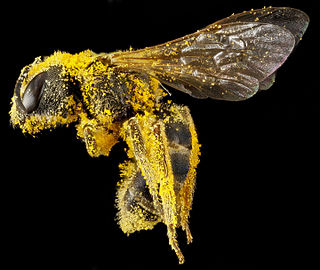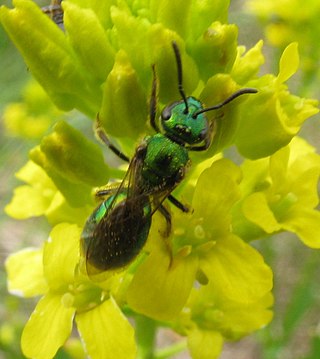
Halictidae is the second-largest family of bees with nearly 4,500 species. They are commonly called sweat bees, as they are often attracted to perspiration. Halictid species are an extremely diverse group that can vary greatly in appearance. These bees occur all over the world and are found on every continent except Antarctica. Usually dark-colored and often metallic, halictids are found in various sizes, colors and patterns. Several species are all or partly green and a few are red, purple, or blue. A number of them have yellow markings, especially the males, which commonly have yellow faces, a pattern widespread among the various families of bees. The family is one of many with short tongues and is best distinguished by the arcuate basal vein found on the wing. Females in this family tend to be larger than the males. They are the group for which the term 'eusocial' was first coined by entomologist, Suzanne Batra.

Halictus rubicundus, the orange-legged furrow bee, is a species of sweat bee found throughout the Northern Hemisphere. H. rubicundus entered North America from the Old World during one of two main invasions of Halictus subgenera. These invasions likely occurred via the Bering land bridge at times of low sea level during the Pleistocene epoch.

Lasioglossum malachurum, the sharp-collared furrow bee, is a small European halictid bee. This species is obligately eusocial, with queens and workers, though the differences between the castes are not nearly as extreme as in honey bees. Early taxonomists mistakenly assigned the worker females to a different species from the queens. They are small, shiny, mostly black bees with off-white hair bands at the bases of the abdominal segments. L. malachurum is one of the more extensively studied species in the genus Lasioglossum, also known as sweat bees. Researchers have discovered that the eusocial behavior in colonies of L. malachurum varies significantly dependent upon the region of Europe in which each colony is located.

The genus Agapostemon is a common group of Western Hemisphere sweat bees.

Osmia bicornis is a species of mason bee, and is known as the red mason bee due to its covering of dense gingery hair. It is a solitary bee that nests in holes or stems and is polylectic, meaning it forages pollen from various different flowering plants. These bees can be seen aggregating together and nests in preexisting hollows, choosing not to excavate their own. These bees are not aggressive; they will only sting if handled very roughly and are safe to be closely observed by children. Females only mate once, usually with closely related males. Further, females can determine the sex ratio of their offspring based on their body size, where larger females will invest more in diploid females eggs than small bees. These bees also have trichromatic colour vision and are important pollinators in agriculture.

Anthidium maculosum is a species of bee in the family Megachilidae, the leaf-cutter, carder, or mason bees. It is a solitary bee where the males are territorial and the females take part in polyandry. The males of A. maculosum differ from most other males of bee species because the males are significantly larger than females. In addition, subordinate males that act as satellites are smaller than territory-owning males. This species can be found predominately in Mexico and the United States.

Within the insect order Hymenoptera, the Halictinae are the largest, most diverse, and most recently diverged of the four halictid subfamilies. They comprise over 2400 bee species belonging to the five taxonomic tribes Augochlorini, Thrinchostomini, Caenohalictini, Sphecodini, and Halictini, which some entomologists alternatively organize into the two tribes Augochlorini and Halictini.

Lasioglossum zephyrus is a sweat bee of the family Halictidae, found in the U.S. and Canada. It appears in the literature primarily under the misspelling "zephyrum". It is considered a primitively eusocial bee, although it may be facultatively solitary. The species nests in burrows in the soil.

Halictus ligatus is a species of sweat bee from the family Halictidae, among the species that mine or burrow into the ground to create their nests. H. ligatus, like Lasioglossum zephyrus, is a primitively eusocial bee species, in which aggression is one of the most influential behaviors for establishing hierarchy within the colony, and H. ligatus exhibits both reproductive division of labor and overlapping generations.

Megalopta genalis is a nocturnal species of the family Halictidae, otherwise known as the sweat bees. The bee is native to Central and South America. Its eyes have anatomical adaptations that make them 27 times more sensitive to light than diurnal bees, giving it the ability to be nocturnal. However, its eyes are not completely different from other diurnal bees, but are still apposition compound eyes. The difference therefore lies purely in adaptations to become nocturnal, increasing the success of foraging and minimizing the danger of doing so from predation. This species has served as a model organism in studies of social behavior and night vision in bees.

Lasioglossum cressonii is a species in the sweat bee genus Lasioglossum, family Halictidae. Halictidae exhibit eusocial hierarchy behavior which is interesting given that eusociality in this group is hard to evolve and easy to lose. L. cressonii is found throughout North America. L. cressonii have been shown to be important pollinators for apple trees and many other North American native plants.

Lasioglossum hemichalceum, which has sometimes been confused with L. erythrurum, is a sweat bee endemic to Australia. Large numbers of unrelated females will typically share a single nest, a behavior referred to as "communal". Nests are constructed underground by the independent efforts of the females. L. hemichalceum will typically begin creating new colonies during the summer, with brood production from late November through the first few months of spring. Members of this species do not demonstrate aggressive behavior towards one another. As the size of the colony increases, the reproductive potential of each female does not change, unlike many species of bees.
Lasioglossum figueresi, formerly known as Dialictus figueresi, is a solitary sweat bee that is part of the family Halictidae of the order Hymenoptera. Found in Central America, it nests in vertical earthen banks which are normally inhabited by one, though sometimes two or even three, females. Females die before their larvae hatch. It was named after José Figueres Ferrer, a famous Costa Rican patriot, and studies of its behavior are now general models for social behavior studies.
Lasioglossum aeneiventre, also known as Dialictus aeneiventre, is a social sweat bee and is part of the family Halictidae of the order Hymenoptera. Found in Central America, it nests mostly on flat ground though sometimes in vertical banks. It is often compared to L. figueresi.

Lasioglossum leucozonium, also known as Lasioglossum similis, is a widespread solitary sweat bee found in North America, Europe, Asia, and parts of northern Africa. While now a common bee in North America, population genetic analysis has shown that it is actually an introduced species in this region. This population was most likely founded by a single female bee.

Macropis nuda is a ground nesting, univoltine bee native to northern parts of North America. Thus, this species cocoons as pupae and hibernates over the winter. The species is unusual as it is an oligolectic bee, foraging exclusively for floral oils and pollen from Primulaceae of the species Lysimachia ciliata.

Halictus sexcinctus, commonly referred to as the six-banded furrow bee, is a species of sweat bee found throughout Europe and as far east as Asian Turkey and Iraq. The H. sexcinctus can be easily confused with the closely related species, Halictus scabiosae, due to very similar morphological features. H. sexcinctus show a social polymorphism in which different colonies can exhibit solitary, communal, or eusocial structure. Due to this large variance in social organization, it was suspected that it was not one species at all, but rather multiple, cryptic species. However, genetic analysis was able to confirm these varying populations as one species. H. sexcinctus will forage from multiple flower species, but prefers plant species with wide-open flowers. Their nests can be found dug into the ground in loamy or sandy soil.

Augochlorella is a genus in the bee family Halictidae, commonly called sweat bees. They display metallic coloration, ranging from reddish to gold to bluish green, as is typical for other genera in the tribe Augochlorini.

Lasioglossum sordidum, also referred to as the small native bee, is one of the smallest native bees found in New Zealand.

Augochlorella aurata is a primitively eusocial species of sweat bee in the family Halictidae. It is one of three species of Augochlorella found east of the Rocky Mountains in North America. The body is a brilliant green metallic color, diffused to varying extents with a copper, red, or yellow color. A. aurata is a generalist pollen feeder and likely an important pollinator for some horticultural crops. A common name is golden green sweat bee.




















